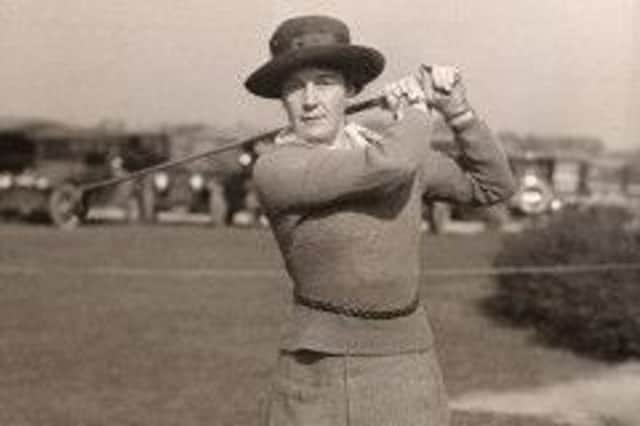Dorothy Campbell: Scotland’s own Merion heroine


However, the last time a Scot won a major championship at the venue it was also a big surprise. In 1909, when North Berwick’s Dorothy Campbell won the US Women’s Amateur Championship at Merion, she defied the odds to do so.
Campbell cemented her place in golf history by being the first non-American to win the US Championship. In the same year, she also won the British Amateur title at Royal Birkdale, becoming the first player to hold the two titles at the same time.
Advertisement
Hide AdAdvertisement
Hide AdOn her induction to the World Golf Hall of Fame in 1978, she was acclaimed as “Women’s golf’s first international star”. Two failed marriages to very successful American businessmen and her later tragic death could not overshadow a brilliant golfing career.
When account is taken of all her major successes – three Scottish, two British, three Canadian and three US amateur titles, it is surprising how relatively little known she is among the golfing public.
Her story began on 24 March 1883 when she was born at 1 Carlton Terrace, Edinburgh, to William and Emily Campbell. Her father was a partner in the family metal merchant business, Thomas B Campbell and Co, of Constitution Street, Leith. Her uncle Thomas built Inchgarry House in Links Road, North Berwick, as a summer house which was shared with family. And it was in North Berwick that she took the first faltering steps in her stellar career by learning the game on the small nine-hole course near The Marine Hotel. It is said she first swung a club at 18 months old and she certainly had lessons from the iconic Ben Sayers, then 3/6d (17p) per hour. Because her father died when she was 16, the family moved to North Berwick to live there permanently after which her game improved considerably.
Her potential was first commented on in 1901 in a magazine, The Irish Golfer, when she defeated American Lady Champion Frances Griscom at North Berwick in August that year. Her first major success was in 1905 when she won the Scottish Ladies Amateur Championship over her home course in front of a crowd estimated at 4,000. She retained the title at Cruden Bay and also won it at Gullane in 1908, when she also reached the final of the British Amateur at St Andrews, losing only at the first extra hole. Among the 9,000 spectators was Old Tom Morris, who died two days later.
Then came her success at Merion, winning the US Championship by 3 and 2 against the much more fancied Nonna Barlow, a local resident and Merion club member. As winner, she was presented with the Robert Cox Trophy which had been donated to the US Golf Association in 1896 by Robert Cox, of Gorgie, Edinburgh. Cox was MP for Edinburgh South and had developed his love of the game at Musselburgh while a pupil at Loretto School.
The trophy is encrusted with thistles and adorned with panel scenes of St Andrews and is the only US Golf Association trophy of non-US provenance.
In 1910, she moved to Hamilton, Ontario, winning the first of her three consecutive Canadian titles and retaining her US Championship at Homewood Country Club, Illinois. She returned to the UK briefly in 1911 to win her second British amateur title at Portrush before settling in the United States where, in 1913, she married steel magnate Jack Hurd, of Pittsburgh. Hurd was a member of the famous nearby Oakmont Course where North Berwick’s Tom Anderson Jr was the professional.
Marriage and the subsequent birth of her son relegated golf to the sidelines for a while but, after she divorced in 1923, she resumed her career under tuition of the Merion club professional, George Sayers, of the famous North Berwick golfing dynasty. He taught her to change her unorthodox grip to the ‘Vardon’ grip and to adopt a more athletic swing.
Advertisement
Hide AdAdvertisement
Hide AdThe tuition paid dividends as the following year she won her third US Championship at Rhode Island at the age of 41, making her the oldest winner of that title. In the final, she defeated Mary Browne, the American tennis champion of 1912 and 1913, by 7 and 6.
The 14 years that spanned the period from her previous success is also the longest gap between wins in that competition.
She continued playing competitively with success throughout the 1920s and ’30s, representing Scotland with distinction in the Home Internationals of 1928 and 1930, while, in 1938, she won the US seniors title.
In 1926, she had set a record for the lowest number of putts in a round, taking only 19 over Augusta Country Club with her trusty putter, which she nicknamed “Stella”, beating the record held by triple American Amateur champion Walter Travis by two strokes.
In 1937, she married again, this time to Edward Howe, the chairman of Princeton New Jersey Bank and Trust Company but that ended in divorce in 1943.
On 20 December, 1945, after visiting friends in Beaufort, South Carolina, Dorothy set off to visit her daughter-in-law, Sigourney Hurd in Pleasantville, New York, while her son was stationed in the Phillipines in the army.
When changing trains at Yemussee, South Carolina, she was struck by the New York-bound express and died instantly. She was 61.
Her outstanding achievements have probably not been fully recognised, here at any rate. Should one of her compatriots follow in her footsteps by succeeding this week at Merion, there is no doubt that success alone will guarantee him lasting celebrity.